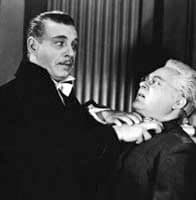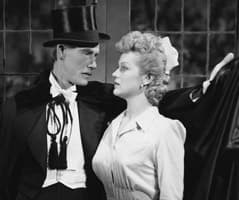Dracula
Critique • Quotes • Text • Dracula at the movies
 First edition
First editionFirst publication
1897
Literature form
Novel
Genres
Literary, fantasy
Writing language
English
Author's country
England
Length
Approx. 180,000 words

Gloria Holden tries to disown her vampiric legacy as Dracula's daughter in 1936 film.
Dracula's kids
Dracula's Daughter (1936): Film, 69–72 minutes; director Lambert Hillyer; writers John L. Balderston, Kurt Neumann; featuring Gloria Holden, Otto Kruger, Marguerite Churchill
Son of Dracula (1943): Film, 78 minutes; director Robert Siodmak; writers Eric Taylor, Curt Siodmak; featuring Lon Chaney Jr., Louise Allbritton
House of Frankenstein (1945): Film, 70 minutes; director Erle C. Kenton; writers Edward T. Lowe, Curt Siodmak; featuring Gloria Holden, John Carradine, Lon Chaney Jr., Boris Karloff, Glenn Strange
After the wild success of Lugosi's Dracula, Universal continued, as it did with the Frankenstein franchise, to milk everything it could from the titular character.
But the next effort, Dracula's Daughter (1936) doesn't quite fit the sequel mould. For one thing, the villain of the original didn't return.
The action starts only minutes after the abrupt ending of the 1931 flick with Van Helsing (Edward Van Sloan, the only reprising actor) being arrested for the murder of the count who has been found with a stake through his chest.
But after that, the story shifts to a mysterious woman, Countess Marya Zaleska (Gloria Holden), who steals and destroys Dracula's body in order to escape from his thrall.
Her plan doesn't work of course and the rest of the narrative concerns her attempts to battle her own vampiric nature.
This film is supposedly based in part on a chapter that Stoker cut from the novel and which was published posthumously as a story called "Dracula's Guest".
At least one of the scenes in the movie—when the female vampire seduces a young female victim, just as Daddy used to—seems to a twenty-first century audience to be an obvious reference to lesbianism. You could view the whole film as an allegory in that light.
But in the end, Dracula's Daughter becomes another kill-the-vampire story. An interesting, unusual sequel for its time, though not one that really stays with you as Dracula did.
A new face for Dracula
In 1943 the studio revived Dracula himself with Son of Dracula, though without its original star and sporting a new story that ignores its first two films.
I'm not sure where the "Son" in the title comes from—there's speculation that the being who calls himself Dracula in this film is actually a descendant of the original, though this isn't clear.
In any case, this time the count is played by Lon Chaney Jr., who had recently become famous as the Wolf Man and who was son of Lon Chaney (Phantom of the Opera). Chaney Sr. had been unsuccessfully sought for the first film, that had to settle for Bela Lugosi.
It's been a dozen years since the 1931 film and the whole production is more sophisticated, with better visual effects, better sound and more natural acting.
It's ably directed by German-born Robert Siodmak who would go on to make several great film noir thrillers in America, including The Killers. The script is by his brother Curt who also wrote The Wolf Man and other horror flicks.
Trailer for 1943's so-called Son of Dracula movie, a sequel to the 1931's Dracula.
Son of Dracula is a complicated story about the Transylvanian vampire somehow showing up in New Orleans where a woman who dabbles in the supernatural pretends to fall for Dracula, marries him, and then plots to kill him.
Chaney Jr. is not evil or dynamic enough to fill Lugosi's cape but the film is competently put together and diverting enough for a viewing.
Dracula at the monster mash
Dracula was also a character in 1944's monster fest House of Frankenstein with John Carradine as the vampire, Lon Chaney Jr. as the Wolf Man, and Glenn Strange as Frankenstein's monster.
Then the three were reunited the next year when the action moved to the count's new hangout in House of Dracula.
The franchise really falls apart with this one though. The plot goes all over the place with a well-intentioned doctor treating the count, curing the Wolf Man and trying to revive Frankenstein's monster.
Dracula turns on his would-be saviour and is himself put down but not before managing to infuse himself into the doctor who becomes half-vampire and confronts the Frankenstein monster and the man who used to be the Wolf Man. Confused yet? Then it starts getting complicated.
Classic monster fans dig the film for all the elements it brings together and the actors give it what they've got, But as a movie for non-buffs it's a mess.
— Eric
Critique • Quotes • Text • At the movies
1922, 1931, 1936–1945, 1958, 1960–1974, 1979, 1979–1995, 1992, 2000, 2000, 2006, 2023



